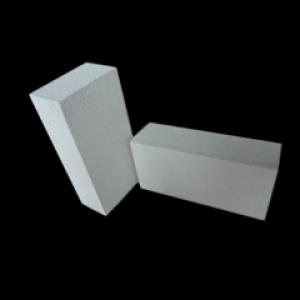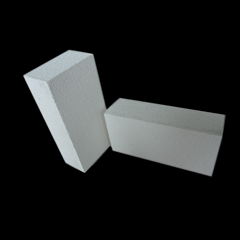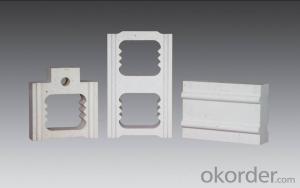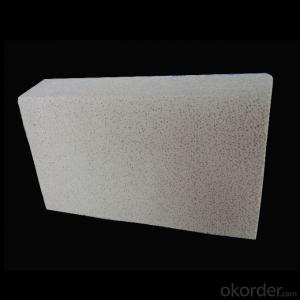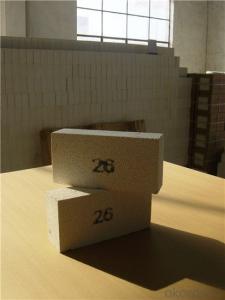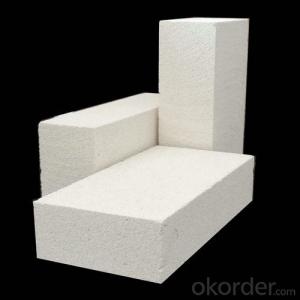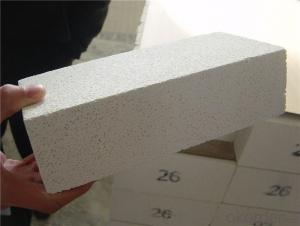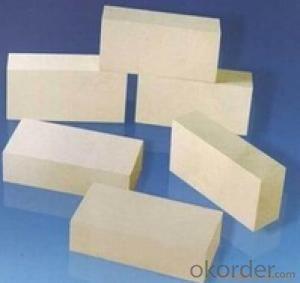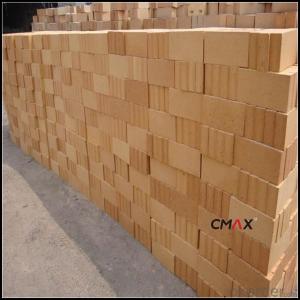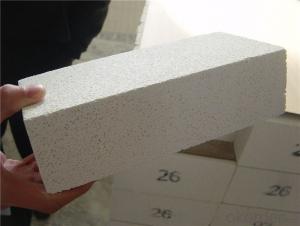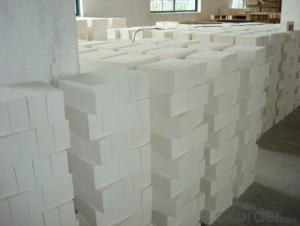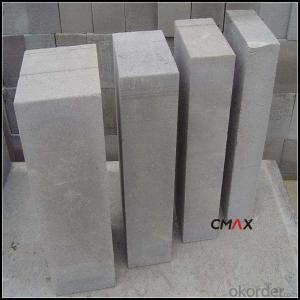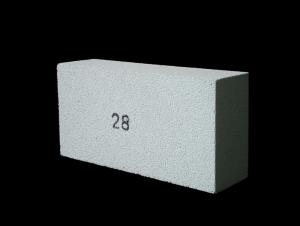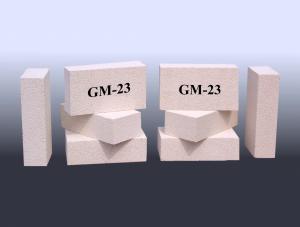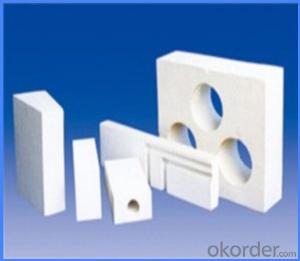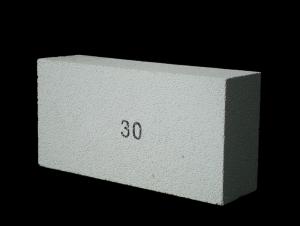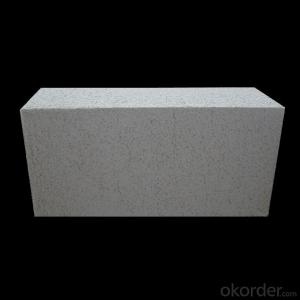Insulating Fire Brick - Insultaing Fire Brick
- Loading Port:
- China Main Port
- Payment Terms:
- TT OR LC
- Min Order Qty:
- -
- Supply Capability:
- -
OKorder Service Pledge
Quality Product, Order Online Tracking, Timely Delivery
OKorder Financial Service
Credit Rating, Credit Services, Credit Purchasing
You Might Also Like
General Information
CMAX insulating firebricks are classified under temperature between 1300℃ to 1700℃, manufactured from high purity alumina clay.
Feature
Light weight and low thermal conductivity
Low heat storage
Low iron and impurities
High thermal shock resistance
Application
CMAX insulating firebricks can be used as a hot face lining directly exposed to the heat or as a backup insulation layer in iron and steel mills, non-ferrous foundries, petrochemical, ceramic, glass.
- Q: Are insulating fire bricks suitable for use in glass melting furnaces?
- Yes, insulating fire bricks are suitable for use in glass melting furnaces. Insulating fire bricks have high thermal resistance and low thermal conductivity, making them ideal for retaining heat and preventing heat loss in the furnace. Additionally, their lightweight and porous nature allow for efficient energy utilization and reduced fuel consumption.
- Q: Is it possible to recycle broken insulating fire bricks?
- Yes, it is possible to recycle broken insulating fire bricks. Insulating fire bricks are commonly made from materials such as clay and alumina, which can be recycled. The broken bricks can be crushed into small particles or ground into a fine powder, and then mixed with other materials to create new bricks or other construction materials. Additionally, some recycling facilities may accept broken insulating fire bricks and process them for reuse in other industries. Recycling broken insulating fire bricks helps to reduce waste, conserve resources, and minimize the environmental impact associated with manufacturing new bricks from scratch.
- Q: What are the main components of insulating fire bricks?
- Insulating fire bricks usually consist of a blend of alumina, silica, and assorted lightweight additives. Alumina (Al2O3) is crucial in insulating fire bricks due to its ability to withstand high temperatures and resist thermal shock. Silica (SiO2) contributes to improving the refractory qualities and insulation abilities of the bricks. Furthermore, vermiculite or perlite, which are lightweight additives, are commonly incorporated to enhance the insulating properties of the bricks. The collaboration of these components produces a material that possesses exceptional thermal insulation, minimal thermal conductivity, and remarkable heat resistance.
- Q: Can insulating fire bricks be used in residential construction?
- Insulating fire bricks, also known as refractory bricks, are primarily designed for high-temperature applications like industrial furnaces and kilns. Their purpose is to withstand extreme heat, have low thermal conductivity, and offer excellent insulation properties. Although insulating fire bricks can be utilized in residential construction, they are not usually the preferred choice for such projects due to various reasons. Firstly, they are considerably more expensive compared to other construction materials available in the market. This cost factor often makes them less desirable for residential projects, where budget considerations are crucial. Secondly, insulating fire bricks are primarily designed to provide thermal insulation in high-temperature environments, which is relatively rare in residential construction. Standard construction materials like concrete blocks, bricks, or insulation boards can usually provide sufficient insulation for residential buildings. Lastly, insulating fire bricks are not as structurally strong as other construction materials, making them less suitable for load-bearing applications in residential construction. These bricks are typically used as a secondary layer or lining in industrial furnaces, rather than being used as the primary building material. In conclusion, although insulating fire bricks can technically be used in residential construction, they are not commonly chosen due to their high cost, limited applicability, and structural limitations. Residential construction typically relies on more cost-effective and versatile materials to meet insulation and structural requirements.
- Q: Are insulating fire bricks resistant to high-velocity gases?
- In general, insulating fire bricks possess resistance to high-velocity gases. These bricks are specifically designed with high thermal resistance and low thermal conductivity, rendering them suitable for situations where exposure to elevated temperatures and gases is prevalent. Without experiencing any damage or compromise, they are capable of enduring the force and speed of gases. In the realm of industrial furnaces, kilns, and other high-temperature settings, insulating fire bricks find common application, as they fulfill the dual role of insulation and safeguard against high-velocity gases.
- Q: Are insulating fire bricks resistant to alkali vapor attack?
- Insulating fire bricks are known for their general resistance to alkali vapor attack. They are crafted from high-quality refractory materials like fire clay or silica, which possess exceptional resistance to chemical assaults, including alkali vapor. These bricks are engineered to endure extreme temperatures and challenging surroundings, rendering them suitable for applications where alkali vapor may be present, such as in industrial furnaces, kilns, and incinerators. However, the level of resistance may vary depending on the specific composition and manufacturing process employed for these insulating fire bricks. To ensure compatibility with alkali vapor exposure, it is advisable to refer to the manufacturer's specifications or seek expert advice.
- Q: Can insulating fire bricks be used for insulation in solar thermal systems?
- Indeed, insulation in solar thermal systems can be achieved by utilizing insulating fire bricks. These bricks have been specifically engineered to possess a low thermal conductivity, enabling them to effectively capture and retain heat. As a result, they prove to be suitable for insulating various components of a solar thermal system, including the solar collector and storage tank, thereby minimizing heat dissipation and enhancing the system's overall efficiency. Furthermore, insulating fire bricks exhibit remarkable resistance to high temperatures, a critical characteristic in solar thermal systems where extreme temperatures can be encountered. In summary, the utilization of insulating fire bricks as insulation in solar thermal systems serves to enhance performance and diminish energy loss.
- Q: What is the weight of insulating fire bricks?
- The size and composition of insulating fire bricks can cause their weight to differ. Typically, each brick weighs around 3.5 to 5 pounds (1.6 to 2.3 kilograms). Nonetheless, it is crucial to consider that this weight may change depending on the manufacturer and the brick's density. To obtain precise weight information for the insulating fire bricks you desire, it is advisable to refer to the product specifications or seek guidance from the supplier.
- Q: Are insulating fire bricks resistant to moisture penetration?
- Yes, insulating fire bricks are resistant to moisture penetration.
- Q: Can insulating fire bricks be used in the construction of pottery kiln shelves?
- Yes, insulating fire bricks can be used in the construction of pottery kiln shelves. These bricks are specifically designed to withstand high temperatures, making them suitable for use in kilns. They provide excellent insulation, helping to maintain consistent heat distribution throughout the kiln and ensuring optimal firing conditions for pottery.
Send your message to us
Insulating Fire Brick - Insultaing Fire Brick
- Loading Port:
- China Main Port
- Payment Terms:
- TT OR LC
- Min Order Qty:
- -
- Supply Capability:
- -
OKorder Service Pledge
Quality Product, Order Online Tracking, Timely Delivery
OKorder Financial Service
Credit Rating, Credit Services, Credit Purchasing
Similar products
Hot products
Hot Searches
Related keywords
